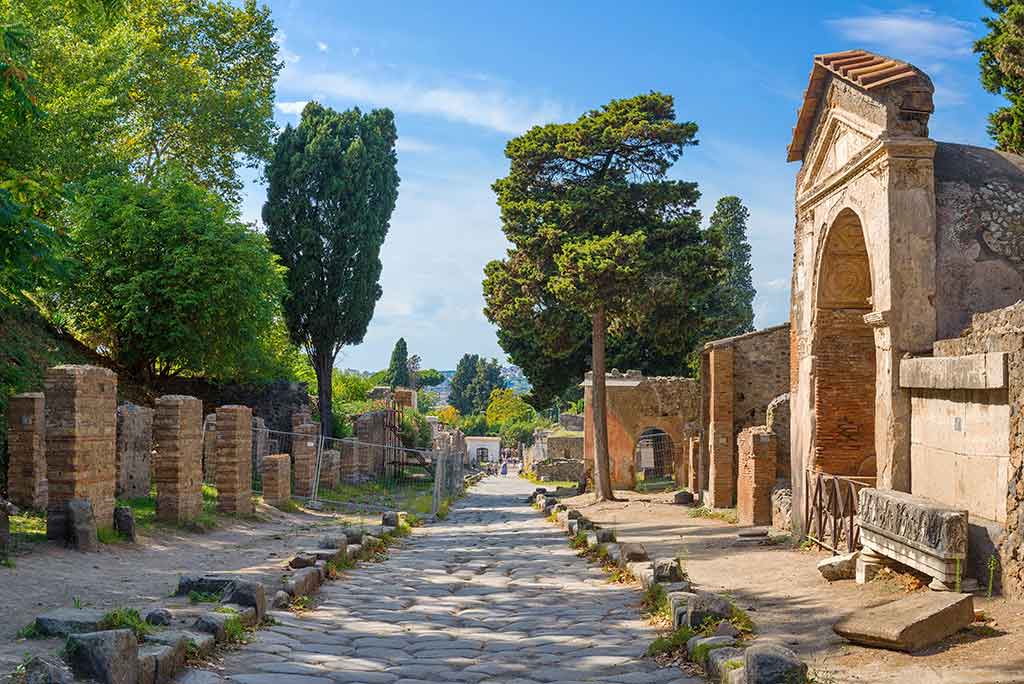
Snapshot of Pompeii, paved street and perfectly preserved buildings
BRIEF HISTORY OF POMPEI
Pompei, found in Italy, is a resort town that is situated in the Roman Empire. It is located in the Campania region in the Bay of Naples, south of Mt. Vesuvius (a volcanic mountain). It was founded by Oscans (Latin people) from the Pompey gen.Most probably, the name Pompei must have originated from these people.
In the 90 BC, Rome conflicted with her allies hence a number of towers were constructed. These towers were used to withstand a siege by the Sulla’s forces. A number of building were constructed here in the 100 years which followed and these included baths, temples, and theaters (an amphitheater and an aqueduct).
After a span of 10 years, the town experienced a great loss when a terrible earthquake shook it (it had experienced a volcanic eruption earlier). Some attempts were made to restore it but only to result to more deaths due to the pockets of escaping gas. The site was abandoned although the Civita settled towards the north on the ashes.
Currently, Pompei is the world’s most experienced in the practices of archaeology and preservation. It is among the list of the most visited tourist attraction centers worlwide. 44 hectares out of the 66 hectares (area covered by Pompei) which were affected have been excavated. The 22 have been left so as to be used by the future generations.
HOW TO GET TO POMPEI
Pompei is served by the Naples International Airport. It is just 29 KM away from the central part of Pompei. It is the most preferred one because of its closeness to Pompei relative to the other nearby ones. Currently, over 50 airlines are operating out of the Naples Aiport.
If unable to find yourself a direct flight to this airport you can use Ciampino-G.B. Pastine International Airport (230KM away in Rome, Italy) or Bari Karol Wojtyla Airport (253 KM away in Bari, Italy).
Once in italy, you can decide on the best means of transport to Pompei and the available ones include bus (SITA bus is most preferred), car or train.
WHAT TO SEE IN POMPEI
The amphitheater
It is located to the excavated area found to the eastern corner near to the Sarno Gate entrance. It measures 135 meters by 104 meters and has got a capacity of 20,000 people. Of all amphitheaters found in the whole world, this is the oldest and the best preserved. The main activities it was used to host included the gladiator battles, spectacles involving wild animals and other sports.
The Forum
Of the three main public baths found in Pompei the one found here are the smallest. They are located inside the archaeological area of the town. Despite their size, they have got everything that is used for the full bathing ritual. The Forum had two sections, one for men and the other for women and each had its own entrance. The frigidarium is in the first chamber and it is where customers (tourists in our case) take a cold birth. A warm birth is also afforded here but in the tepidarium. The other beautiful places to see here include the apodyterium, the courtyard, a Stucco Giant in the tepidarium, the Blazier located in the tepidarium, the Calidarium and the Cold Water Bath that is located in the Calidarium.
The Gymnasium (the Great Palestra)
It is found behind the amphitheater and occupies a very large area. It measures 141 meters by 137 meters. It is a public area that is used as a public gymnasium and a ground for exercises. It was specifically meant for youths and men who participated in sporting activities like wrestling, swimming, discus and for running. At its center is a large swimming pool. The Palaestra has 10 gates and a big wall that is surrounds it. It is a very outstanding monument that is worth seeing in a life time. Its three sides have got lengthy internal colonnades.
Lupanar
This building is located in the corner of two spirits and was built with two storeys. Of all the brothels in Pompei, this is the biggest and most popular. It is also the most visited building on the site with a lot of queues of tourists who are eagerly waiting for their turns to have glimpse of the inside of the Lupanar. Inside it are small rooms with stone beds and some naughty pornographic drawings on the walls that indicate the type of services available in the building.
There are other more great places that you should visit before leaving Pompei. Make sure you exploit the whole of it to derive maximum utility from your tour there.
A dive into the past: Pompei - second part